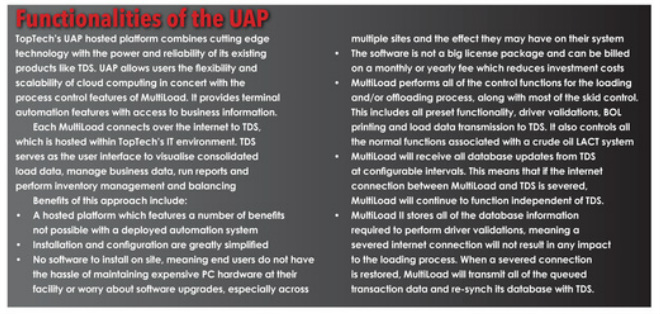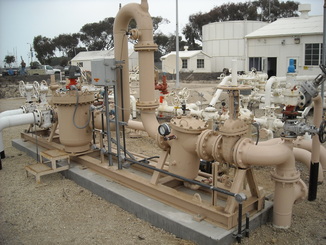A record number of sites are being drilled and produced across the US. These sites generally ship their crude oil by truck to a ‘central’ gathering
point or terminal where it then is either shipped by pipeline or by rail to refineries. Typically the production sites will have a lease automatic custody transfer (LACT) unit or a truck loading LACT. The gathering points will typically have a truck offloading LACT where it takes the crude either directly into a pipeline or a shipping tank. If the crude goes directly into the pipeline it is especially critical to make sure the truck is completely empty
while also ensuring not to introduce air into the system that could cause erroneous measurement problems. Once the crude oil enters a storage tank it is then shipped by either pipeline to the refinery, or by rail. If by pipeline, a LACT unit is usually used. Rail, on the other hand, would see the use of individual loading skids that fit beneath the rail car platforms and provide a bill of lading (BOL) for each rail car or a single high speed loading skid to load many rail cars at once. This encompasses a lot of manual measurement and accounting practices to gather all of this information and to keep track of it, with the end result being to get it billed out and receive payment for the oil. Many companies own multiple sites and need to track all of this oil. Depending on where the custody point is, customers also may require access to this data.
Partnership
Recently PFT-Alexander, a manufacturer of metering systems, truck loaders, offloaders and LACT units, has seen a rise in the need for systems at
remote locations where crude oil is gathered or offloaded. Such a system must seamlessly transfer information that can be monitored and passed on to scheduling, measurement and accounting personnel who are based far away from loading/offloading sites. Customers require a system that is reliable, robust and dependable that can transport this data to them. On the other hand, they do not want to investment a significant amount of money in a custom software solution that could require additional maintenance and upkeep down the line. They are looking for a system that will provide them with crude oil data, from the field, to the gathering point, to the shipping point. Working together with TopTech, a terminal automation software and hardware solutions company, PFT-Alexander has integrated its truck loader/offloader LACT unit package and pipeline LACT unit package with TopTech’s new MultiLoad LACT/truck loader electronics and Unified Automation Platform (UAP) data collection system that gives clients a complete turnkey package while also supplying a seamless transfer of data from remote locations. TopTech serves the terminal and truck loading sectors with its electronic hardware and software. Its electronics platform, known as the MultiLoad II and MultiLoad II Preset, has become the industry standard preset for metering and blending systems. The technology has been used for single product loading to multiple stream products loading and blending.
point or terminal where it then is either shipped by pipeline or by rail to refineries. Typically the production sites will have a lease automatic custody transfer (LACT) unit or a truck loading LACT. The gathering points will typically have a truck offloading LACT where it takes the crude either directly into a pipeline or a shipping tank. If the crude goes directly into the pipeline it is especially critical to make sure the truck is completely empty
while also ensuring not to introduce air into the system that could cause erroneous measurement problems. Once the crude oil enters a storage tank it is then shipped by either pipeline to the refinery, or by rail. If by pipeline, a LACT unit is usually used. Rail, on the other hand, would see the use of individual loading skids that fit beneath the rail car platforms and provide a bill of lading (BOL) for each rail car or a single high speed loading skid to load many rail cars at once. This encompasses a lot of manual measurement and accounting practices to gather all of this information and to keep track of it, with the end result being to get it billed out and receive payment for the oil. Many companies own multiple sites and need to track all of this oil. Depending on where the custody point is, customers also may require access to this data.
Partnership
Recently PFT-Alexander, a manufacturer of metering systems, truck loaders, offloaders and LACT units, has seen a rise in the need for systems at
remote locations where crude oil is gathered or offloaded. Such a system must seamlessly transfer information that can be monitored and passed on to scheduling, measurement and accounting personnel who are based far away from loading/offloading sites. Customers require a system that is reliable, robust and dependable that can transport this data to them. On the other hand, they do not want to investment a significant amount of money in a custom software solution that could require additional maintenance and upkeep down the line. They are looking for a system that will provide them with crude oil data, from the field, to the gathering point, to the shipping point. Working together with TopTech, a terminal automation software and hardware solutions company, PFT-Alexander has integrated its truck loader/offloader LACT unit package and pipeline LACT unit package with TopTech’s new MultiLoad LACT/truck loader electronics and Unified Automation Platform (UAP) data collection system that gives clients a complete turnkey package while also supplying a seamless transfer of data from remote locations. TopTech serves the terminal and truck loading sectors with its electronic hardware and software. Its electronics platform, known as the MultiLoad II and MultiLoad II Preset, has become the industry standard preset for metering and blending systems. The technology has been used for single product loading to multiple stream products loading and blending.
The new unit, termed the MultiLACT, will in most cases replace the programmable logic controller (PLC) that is typically provided with a crude metering/LACT skid, or minimize the need for a PLC. In most cases, it also eliminates the need for a flow computer and/or a temperature averager.
Customer satisfaction
There are many iterations of a crude oil truck or railcar loading skid. It can be a simple loader consisting of a strainer, meter, control valve and loading arm, along with an electronic preset and grounding system. After that the customer can choose to add in oil/water monitoring, a divert system, mixers, samplers, sample container, proving connections and depending on the product, overfill protection as well. The offloaders will have an added air eliminator with controls to ensure the truck is completely empty while making sure air is not introduced into the system. The MultiLoad II will monitor the progress and shut down the unit when the truck is empty and will generate a ticket like the loader. A vapour line with the correct hose and check valve can also be installed, in addition to a detonation flame arrestor and, where required, a vapour exchange solution. The MultiLoad is able to handle typical functions of a truck loading LACT, including preset amounts, temperature compensation, sampling, oil/water cut monitor, failure alarms and divert system along with ticket printing capability. The preset amount on the offloading does not have to be set unless desired as it will shut the system down when the truck or railcar is empty. The new unit combines all of this together and sends the data to TopTech’s UAP where the customer can see the data in real time, reprint BOLs and export the tickets for billing. Communications are simple and flexible. The unit comes equipped with an ethernet port. From that point it can be hard wired via ethernet or ethernet to fiber optic back to an office, via wifi if available, or by cell or satellite. MultiLoad II has been successfully deployed with these wireless connectivity options. This flexibility is required in a number of applications where they are remote and even unmanned and allow customers to utilise MultiLoad in virtually any environment or application. All that is required is an internet connection so the data can be sent to the UAP hosted data platform. The data is 128 bit encryption. Once connected, programming and troubleshooting can be carried out remotely, set points adjusted and changes made. If the internet connection is lost, loading will continue as the MultiLoad will store all of the data and upload it once the connection returns. This unit is a cost-effective solution to a problem many are experiencing with the growing pains of our industry.
There are many iterations of a crude oil truck or railcar loading skid. It can be a simple loader consisting of a strainer, meter, control valve and loading arm, along with an electronic preset and grounding system. After that the customer can choose to add in oil/water monitoring, a divert system, mixers, samplers, sample container, proving connections and depending on the product, overfill protection as well. The offloaders will have an added air eliminator with controls to ensure the truck is completely empty while making sure air is not introduced into the system. The MultiLoad II will monitor the progress and shut down the unit when the truck is empty and will generate a ticket like the loader. A vapour line with the correct hose and check valve can also be installed, in addition to a detonation flame arrestor and, where required, a vapour exchange solution. The MultiLoad is able to handle typical functions of a truck loading LACT, including preset amounts, temperature compensation, sampling, oil/water cut monitor, failure alarms and divert system along with ticket printing capability. The preset amount on the offloading does not have to be set unless desired as it will shut the system down when the truck or railcar is empty. The new unit combines all of this together and sends the data to TopTech’s UAP where the customer can see the data in real time, reprint BOLs and export the tickets for billing. Communications are simple and flexible. The unit comes equipped with an ethernet port. From that point it can be hard wired via ethernet or ethernet to fiber optic back to an office, via wifi if available, or by cell or satellite. MultiLoad II has been successfully deployed with these wireless connectivity options. This flexibility is required in a number of applications where they are remote and even unmanned and allow customers to utilise MultiLoad in virtually any environment or application. All that is required is an internet connection so the data can be sent to the UAP hosted data platform. The data is 128 bit encryption. Once connected, programming and troubleshooting can be carried out remotely, set points adjusted and changes made. If the internet connection is lost, loading will continue as the MultiLoad will store all of the data and upload it once the connection returns. This unit is a cost-effective solution to a problem many are experiencing with the growing pains of our industry.





